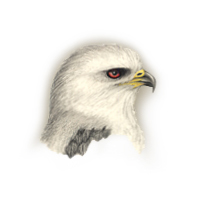|
Field
Guide IDs: BREEDING:
Savanna, riparian
woodland, marsh, partially cleared or cultivated
fields, grassy foothills. Occ 2 broods. DISPLAYS:
Slow circling
flight by pair, one passes below, rolls onto back
as if to pass food, but interlocks feet with
mate. NEST:
In treetop,
camouflaged from below but open above. Flimsy to
well made, large and deep; of twigs, lined with
grass, stubble, rootlets, moss, inner bark, etc.
Often perennial. EGGS:
White, marked with
brown. 1.7" (42 mm). DIET:
Esp California vole
and other rodents, also birds, snakes, lizards,
frogs, and large insects. CONSERVATION:
Winters within U.S.
N.A. range greatly expanded since l960; probably
the only raptor to have benefited from agricultural
expansion. Aided by high adaptability to habitat
disruption and increased abundance of
rodents. NOTES:
Under favorable
conditions, nest semicolonially. Male does all of
hunting for female and young from incubation until
near fledging. Food transferred from hunter to mate
in midair. Often hover with legs dangling. Roost
communally in winter (to >100 birds) but usu
hunt solitarily. Formerly known as Black-shouldered
Kite. More common in
adjacent foothills, but a few pairs are present in
the southern portions of campus. At least one pair
has nested regularly in the faculty housing
area. ESSAYS: REFERENCES:
Brown and Amadon,
1968; Cramp and Simmons, 1980; Eisenmann, 1971;
Warner and Rudd, 1975. |
